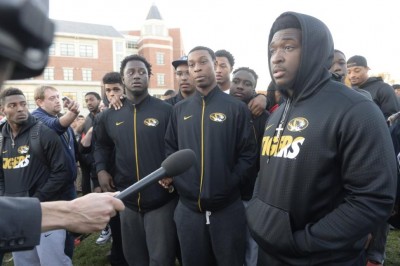
Too often, Black college athletes are referenced in negative commentary, whether in relation to low-graduation rates or NCAA sanctions. Contrary to commonly distorted perspectives, the University of Missouri (UM) football players’ actions in recent weeks epitomize the purpose of higher education, which is to stimulate critical thought and cultivate change.
The protests by the UM football players – and subsequent resignation of UM President Tim Wolfe – also bring to the forefront several realities about U.S. society.
One, the protests highlighted the vast power individuals involved in sport, particularly athletes, possess to ignite social change. The actions by the UM football players come on the heels of Northwestern University football players’ efforts to secure unionization status to increase their rights as college athletes within the exploitive structure of the National Collegiate Athletic Association (NCAA). As recently as 2013, Grambling State football players sat out of athletic activities until their concerns about working in outdated athletic facilities were fully recognized and addressed.
In all three instances, a small group of college athletes decided to take a stand for their rights, and national media attention followed shortly thereafter. Rather than remain silent, these courageous athletes decided to be more than glorified entertainers as Division I football players and instead used their high visibility, platform, and agency to draw attention to the various racial issues on their campus.
Similar to their predecessors and former athlete activists such as Muhammad Ali, Arthur Ashe, Bill Russell, Jim Brown, and Jackie Robinson, the UM football players used their platform as athletes to engage in social activism.
Another reality the UM students’ protest revealed was the power of unified and organized actions. One of the most powerful strategies of the Civil Rights Movement was the use of peaceful protests and organized leadership that outlined clear and tangible goals. The collective influence of Jonathan Butler’s hunger strike, the UM football players’ decision to not participate in athletic activities, and the various other student protests at UM signified how concerted, multifaceted efforts can lead to change.
In addition, the clear and tangible goal presented by the Concerned Student 1950 – an activist group named for the year African-American students were first admitted to UM – of demanding President Wolfe’s resignation as result of his lack of responsive leadership was another key strength of this movement. In this unified effort, Black students at UM leveraged their respective influences to ensure their concerns about the racial climate on campus no longer went overlooked.
“Society not only pays attention when Black athletes score touchdowns and make tackles, but also when they take a stand to fight for social justice and racial harmony.”
– Joseph Cooper, assistant professor of sport management
A third reality the UM students’ protest situation revealed was this: We still do not live in a post-racial society. Despite the fact that we have elected our first biracial president to two consecutive terms, the U.S. continues to struggle with the vicissitudes of racism. Butler, the graduate student who spearheaded the protests with his self-imposed hunger strike, cited how during his student tenure at UM he had been called “nigger” on multiple occasions, as well as experienced physical altercations that were racially driven. Although these instances were reported by one individual, in no way are they isolated. Similar experiences were highlighted in the Concerned Student 1950 grievances.
Furthermore, similar instances are experienced by Black students at historically White institutions of higher education across the U.S. and have been since schools were racially integrated in the mid-20th century. The problem with racism not only lies in persistent overt acts of hatred and discrimination, but also in the passive acceptance or laissez-faire response to these occurrences by those in leadership positions.
Sports do not operate in a vacuum. It is not a coincidence that UM is located in the same state as the recent Ferguson tragedy and protests. Although Columbia, Mo., and Ferguson, Mo., are two different places, similar racial issues are present. For example, the racial demographics of the leadership in Ferguson – namely, the police force – are eerily similar to the leadership at UM; both are predominantly White. Also similar to Ferguson, the persistent racial issues at UM did not receive widespread media attention until large protests ensued. In other words, racism is a lived reality for many American citizens – the Black students at UM and the Black citizens in Ferguson among them – and it takes demonstrative efforts to prove to others that we do not live in a post-racial society.
One lesson we all can learn from the UM student protest is society not only pays attention when Black athletes score touchdowns and make tackles, but also when they take a stand to fight for social justice and racial harmony.
Joseph Cooper is an assistant professor of sport management at the University of Connecticut’s Neag School of Education in Storrs, Conn. His areas of expertise include gender and race in sport and racism, and his research agenda focuses on the nexus between sport, education, race, and culture with an emphasis on sport as a catalyst for holistic development and positive changes in society.
 Facebook
Facebook
 Twitter
Twitter
 LinkedIn
LinkedIn
